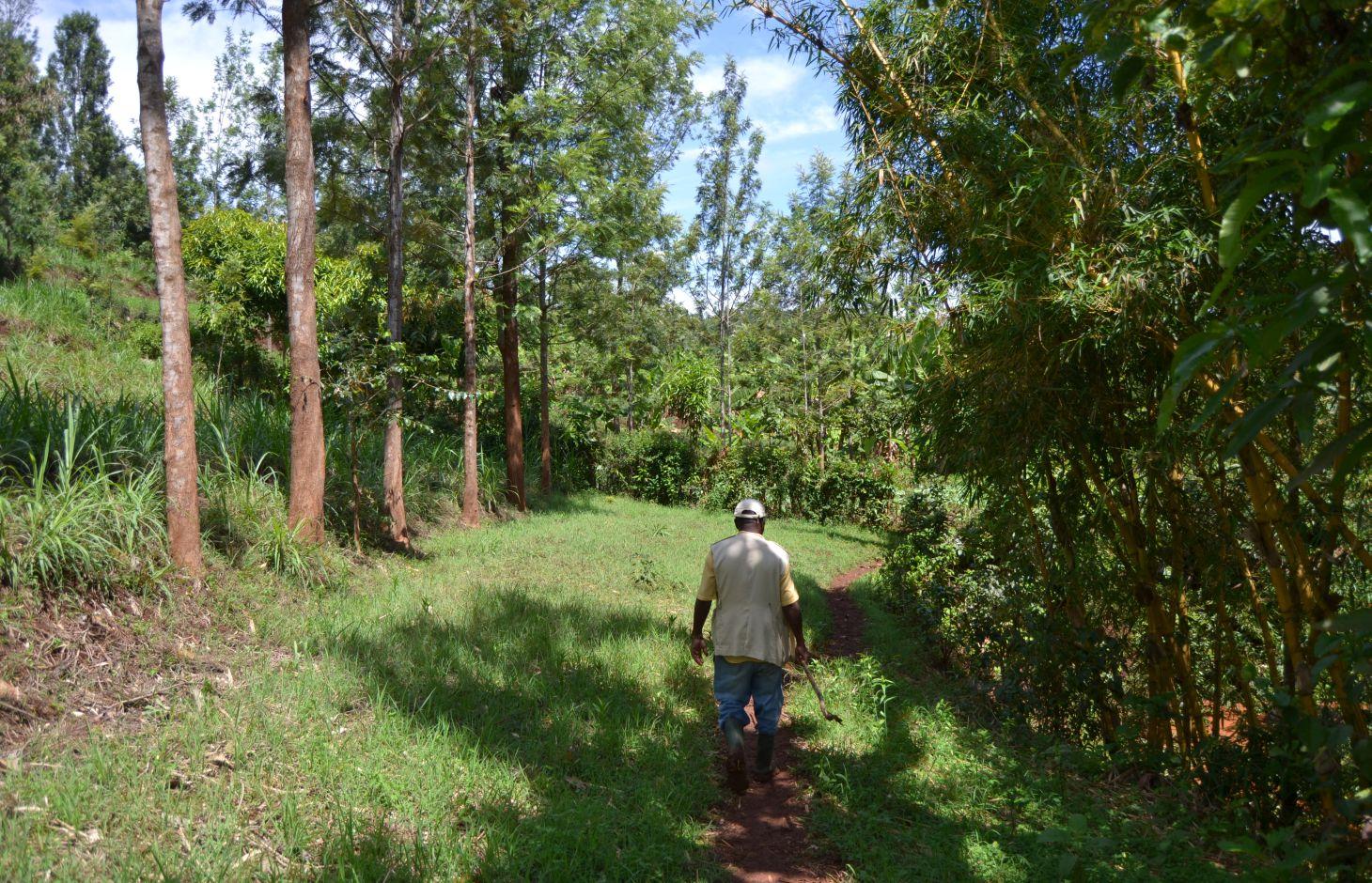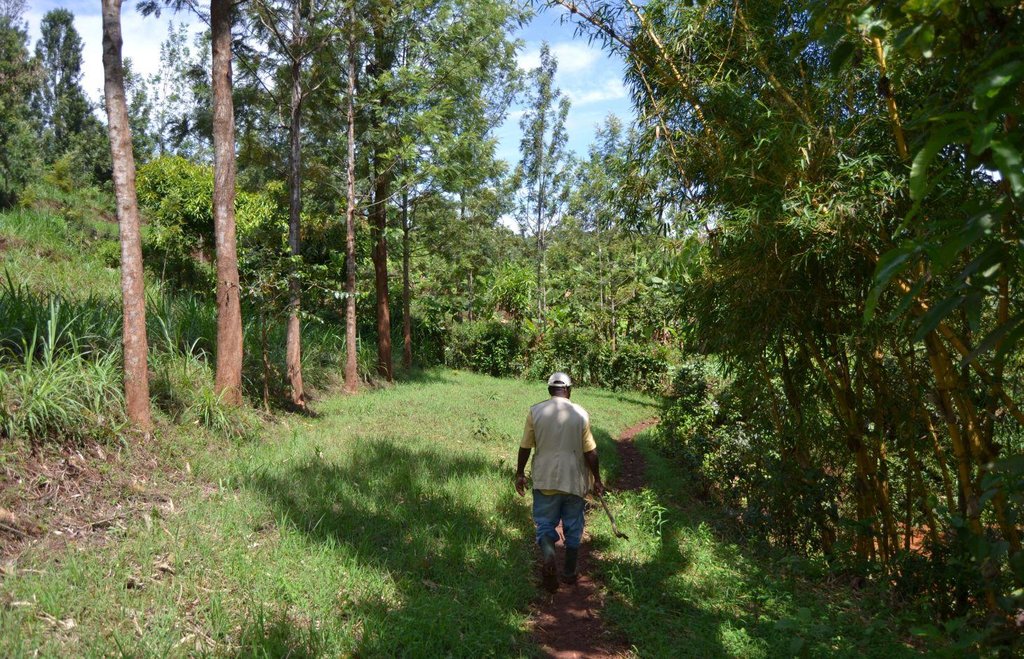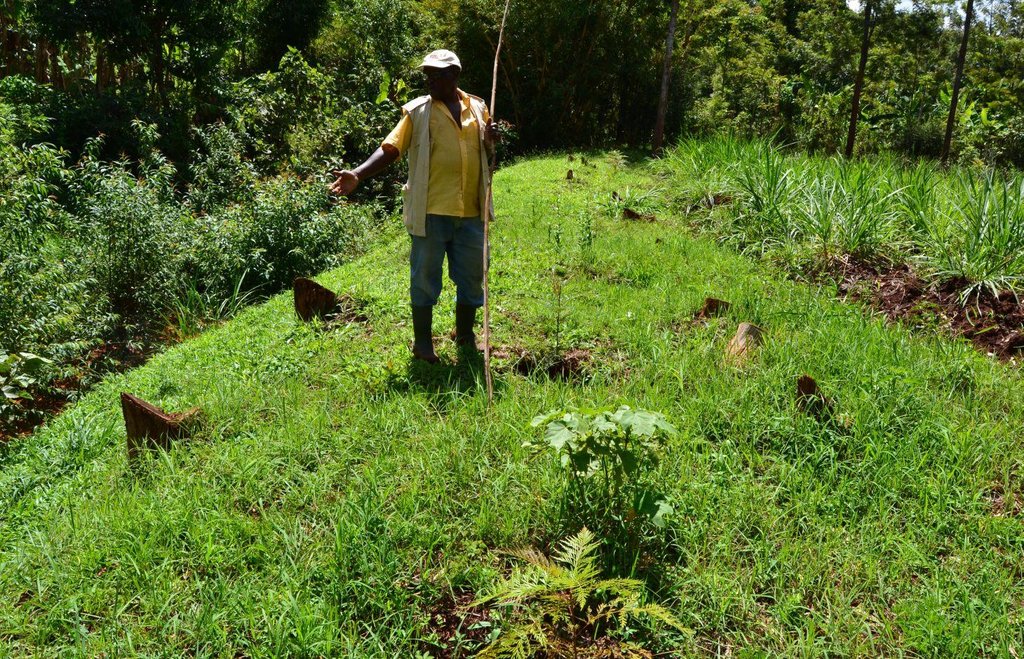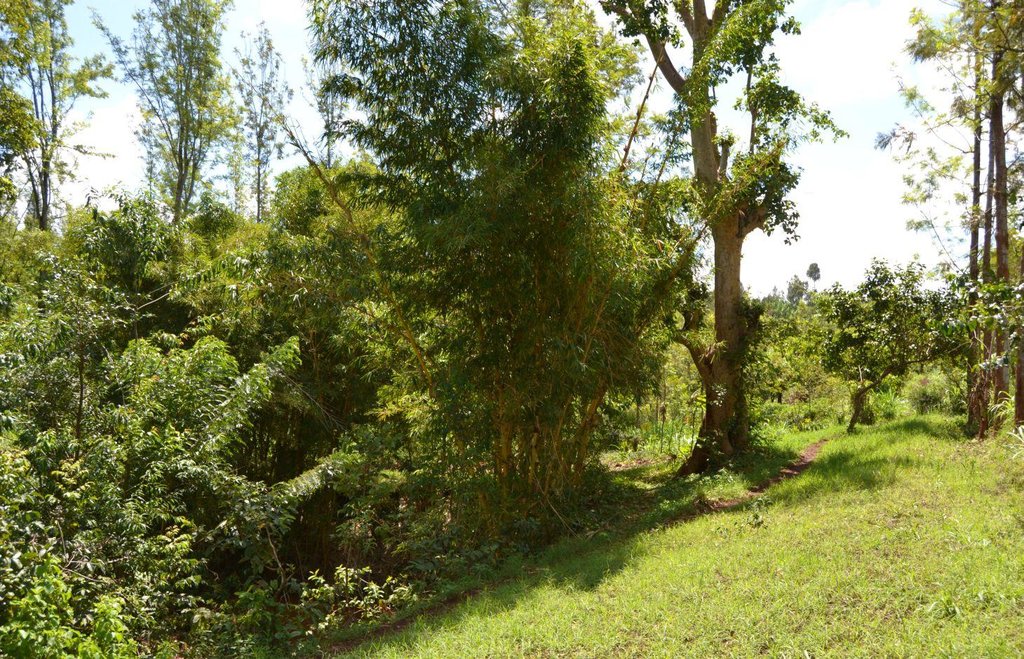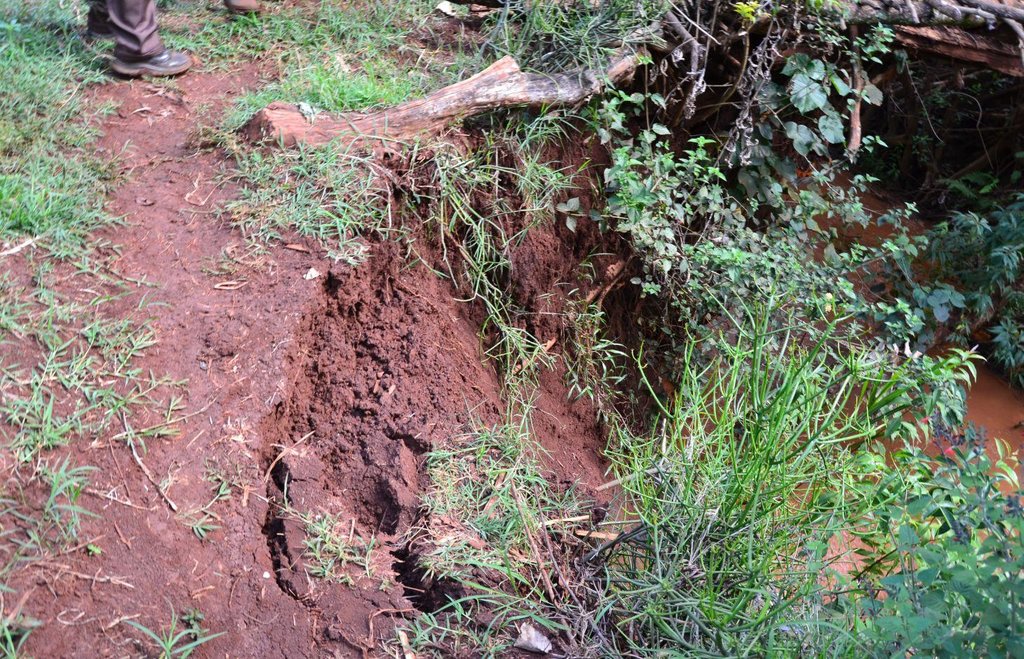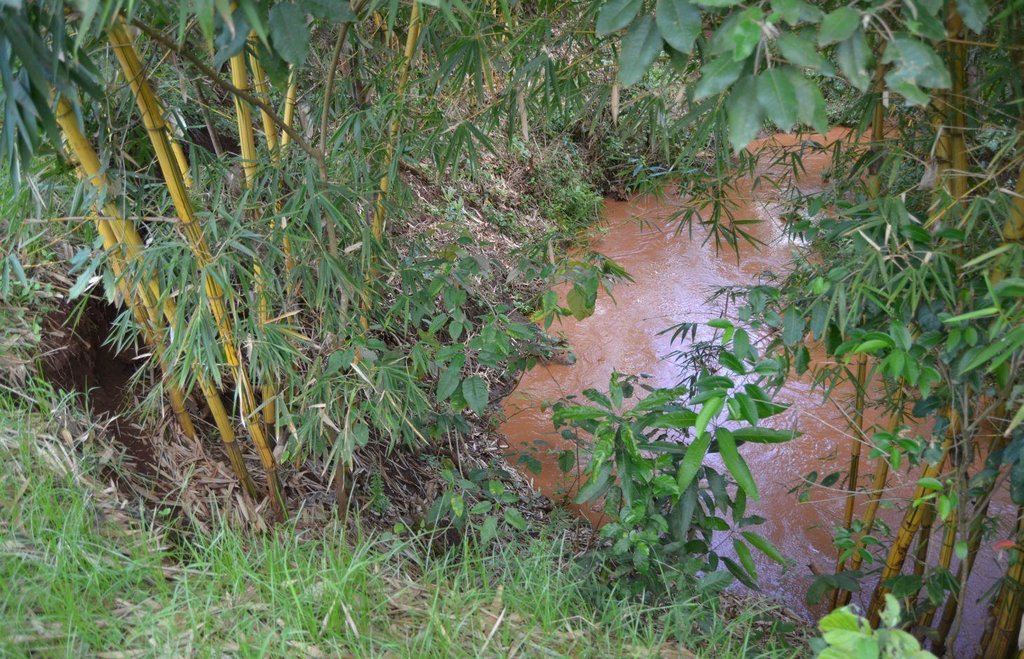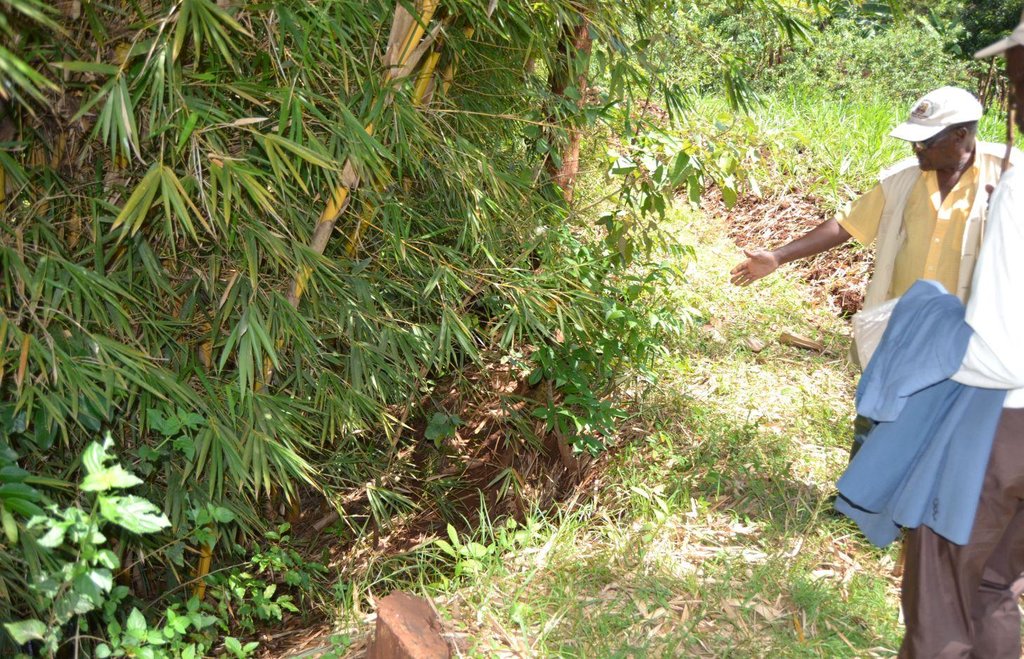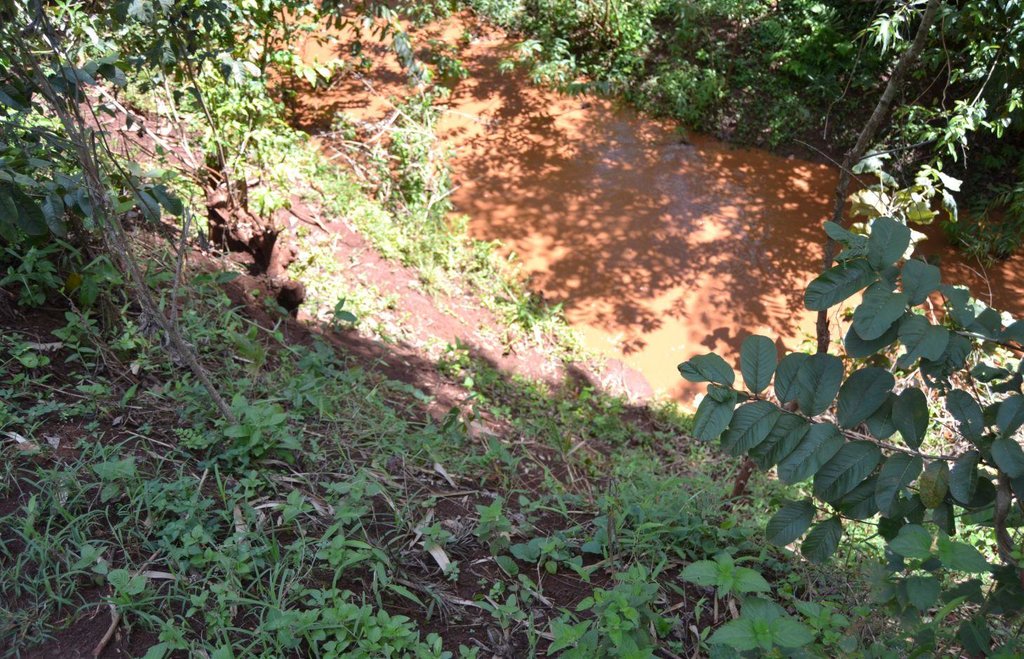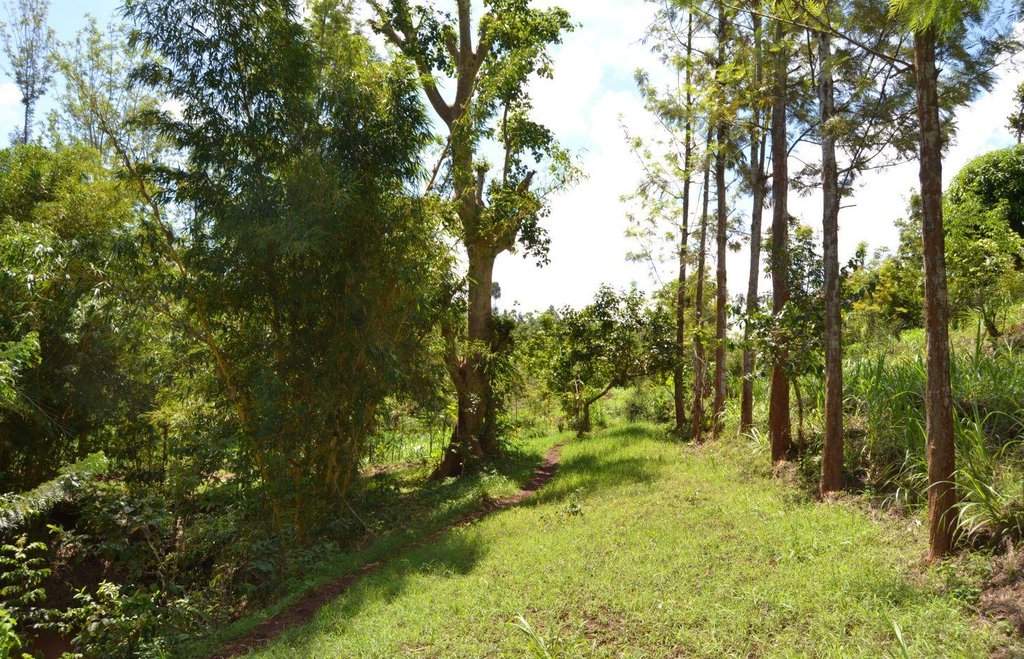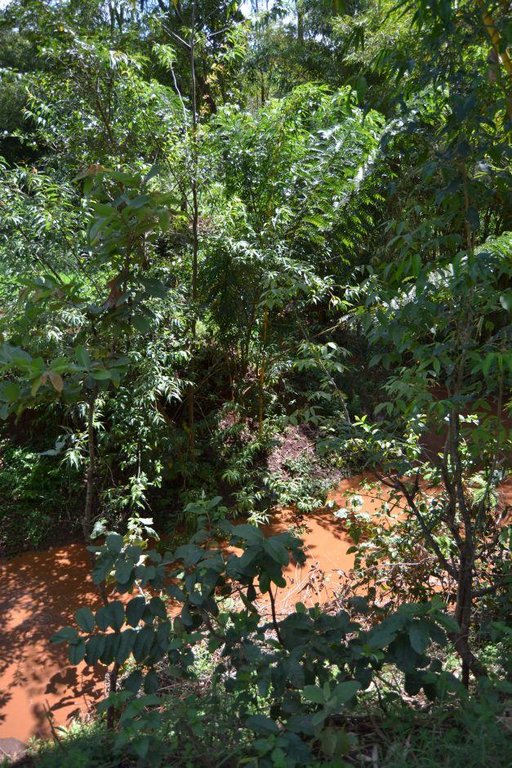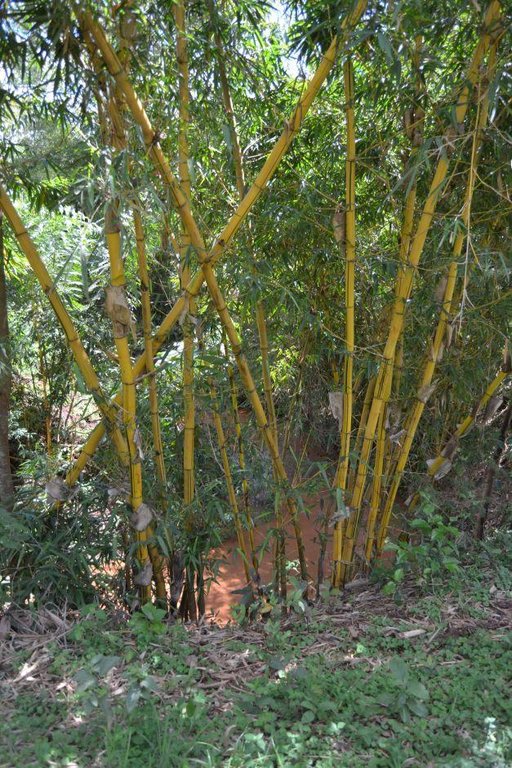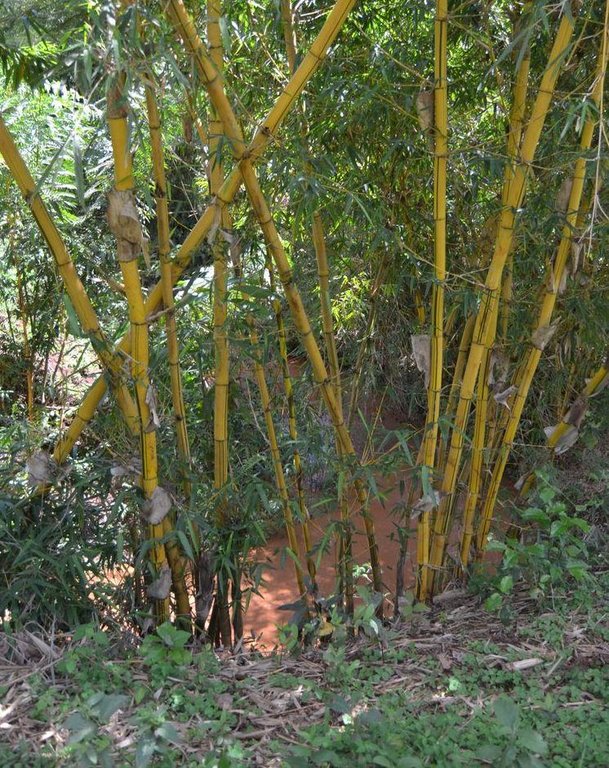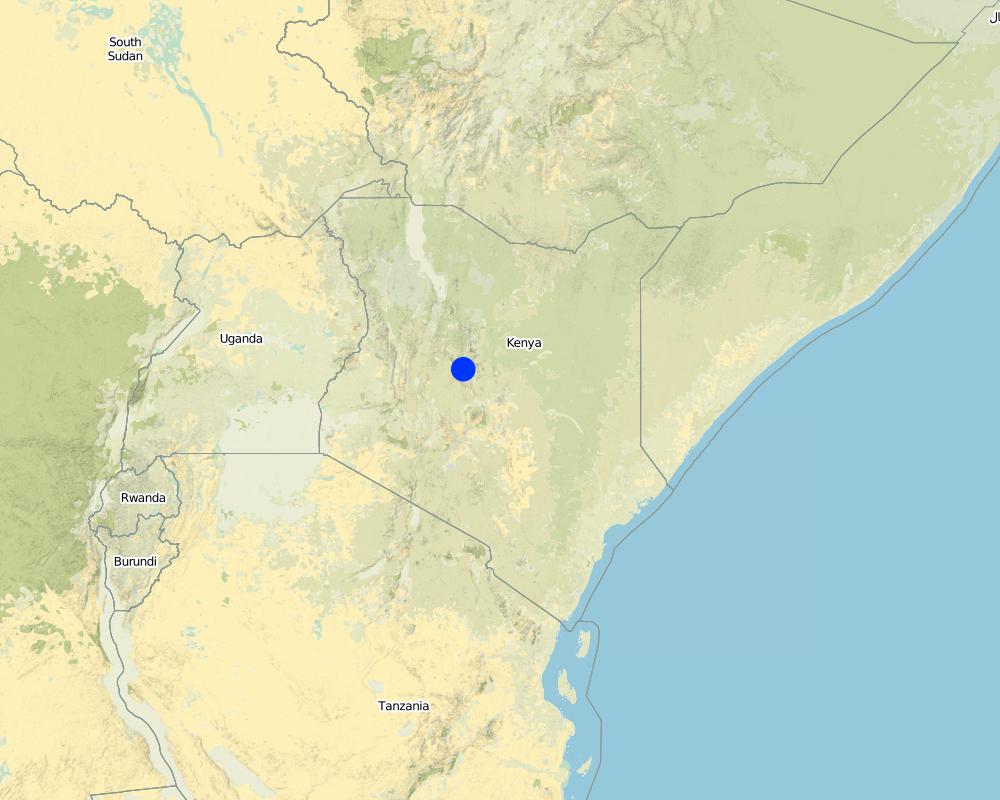Planting Bamboes and Grevillea for Riparian Land Conservation [肯尼亚]
- 创建:
- 更新:
- 编制者: Laura D'Aietti
- 编辑者: –
- 审查者: David Streiff, Alexandra Gavilano
technologies_1135 - 肯尼亚
查看章节
全部展开 全部收起1. 一般信息
1.2 参与该技术评估和文件编制的资源人员和机构的联系方式
SLM专业人员:
F. K. Nyamu Joseph
Saba Saba WRUA
肯尼亚
有助于对技术进行记录/评估的机构名称(如相关)
FAO Food and Agriculture Organization (FAO Food and Agriculture Organization) - 意大利有助于对技术进行记录/评估的机构名称(如相关)
Saba Saba Water Resource Users Association (Saba Saba WRUA) - 肯尼亚1.3 关于使用通过WOCAT记录的数据的条件
编制者和关键资源人员接受有关使用通过WOCAT记录数据的条件。:
是
2. SLM技术的说明
2.1 技术简介
技术定义:
The technology is based on tree plantation of several species (i.e. Grevillea robusta, Psidium guava, Bambusa vulgaris ) along the riparian land of the farmer.
2.2 技术的详细说明
说明:
The practice carried out voluntary by the farmer consists of planting trees at the edge of the river bank and in its proximity.
Purpose of the Technology: By increasing vegetation cover (started 10 year ago) the intention of the farmer is to reduce and control bank erosion and landslides in the riparian land.
The degradation in this area is in fact evident and it is partially explained by the reduced vegetative cover. The planted trees help to maintain water quality by filtering silt and organic materials from rainwater runoff from the upper area and at the same time reinforce the streambank to control erosion. Another important environmental benefit is the increased carbon allocation from the new root systems.
The farmer also mentioned the interest to continue expanding tree plantation also in view of carbon credit and financial support from local authorities: in particular bamboo, which reaches maturity in few years, can be harvested after about two years and is easy to propagate (vegetatively).
Grevillea trees (timber) are seen by the farmer as a form of saving, and sold out when the farmer is in need of cash, earning between 800 up to 1500 KSh (Kenyan Shillings), depending on the size of the tree and the costs for cutting- transportation (e.g. machine operator between 500-700 KSh).
Establishment / maintenance activities and inputs: The initial inputs for the establishment of the vegetative practices concern mainly labour (e.g. planting trees) and the cost of the seedlings (10 KSh seedlings of Grevillea, 20 KSh of Guava); generally these activities are carried out at the beginning of the rainy season. Pruning of Grevillea is done every three seasons.
Natural / human environment: The climate is sub humid with two rainy seasons (the first starts around March and the second around October). Near the river the area is characterized by gentle slope and deposition of sediments and bank erosion are the main processes; the risks of further degradation and water pollution are reduced by the riparian vegetation and thanks to the good land management practices of the surrounding farmers. The riparian land is the area of min 6-30 m around the river and it is considered by law a protected area; therefore it should be left intact from any human activity (Water Act, 2002). Indeed, the 'control' and daily management is carried out by the riparian farmers in collaboration with Sabasaba WRUA and WRMA, the official authority for the management of the water of the river and the riparian land.
In this site in particular, the water of the river is considered clean by the farmer interviewed, despite the fact that during rainy seasons the sediment loads affect the quality of the water.
2.3 技术照片
2.5 已应用该技术的、本评估所涵盖的国家/地区/地点
国家:
肯尼亚
区域/州/省:
Kenya
有关地点的进一步说明:
GATWAMIKWA village, Kagurumo sublocation, Muthithi location
注释:
Total area covered by the SLM Technology is 0,1 ha m2.
Map
×2.6 实施日期
如果不知道确切的年份,请说明大概的日期:
- 不到10年前(最近)
2.7 技术介绍
详细说明该技术是如何引入的:
- 通过土地使用者的创新
注释(项目类型等):
Since year 2000 the farmer has been adopted SWC practices: this in reply to the prolonged degrading situation at the hedge of the river: 'natural vegetation was 'not good' and so 'it was no properly holding the soil', he said.
3. SLM技术的分类
3.1 该技术的主要目的
- 减少、预防、恢复土地退化
3.2 应用该技术的当前土地利用类型

农田
- 乔木与灌木的种植
乔木和灌木种植 - 指定作物:
- 芒果、山竹果、番石榴
每年的生长季节数:
- 2
具体说明:
Longest growing period in days: 122 Longest growing period from month to month: from about March to June Second longest growing period in days: 61 Second longest growing period from month to month: from about October to November

森林/林地
- few lines of Grevillea/Bamboes (According to the definitions adopted FAO (FRA, 2010) the land could not be considered as wooded land (less than 0.5 ha).)
树木类型:
- 竹子
- 银桦
产品和服务:
- 自然保持/保护
- source of cash
注释:
Tree plantation of several species (i.e. Grevillea robusta, Psidium guava, Bambusa vulgaris )
Major land use problems (compiler’s opinion): Risk of bank erosion and deposition of sediments in the river. See Appendix 3. Fig. 2.
Major land use problems (land users’ perception): Bank erosion. See Appendix 3. Fig. 3
Other type of forest: few lines of Grevillea/Bamboes: According to the definitions adopted FAO (FRA, 2010) the land could not be considered as wooded land (less than 0.5 ha).
Problems / comments regarding forest use: Bamboos are planted because of environmental benefits of this plant to stabilize riverbank. Other potential uses: e.g. wood is used to make baskets, fences and various kind of construction; leaves are used to feed chickens. The hollow sections between nodes are used to make containers. Indeed, the farmer let neighbours to clear and use some bamboos.
Forest products and services: nature conservation / protection
Other forest products and services: source of cash
3.5 该技术所属的SLM组
- 改良的地面/植被覆盖
- 改良植物品种/动物品种
3.6 包含该技术的可持续土地管理措施

农艺措施
- A7:其它

植物措施
- V1:乔木和灌木覆盖层
注释:
Main measures: vegetative measures
Secondary measures: agronomic measures
Type of vegetative measures: aligned: -along boundary, scattered / dispersed
3.7 该技术强调的主要土地退化类型

土壤水蚀
- Wm:块体运动/滑坡
- Wr:河岸侵蚀

水质恶化
- Hp:地表水水质下降
注释:
Main type of degradation addressed: Wr: riverbank erosion, Hp: decline of surface water quality
Secondary types of degradation addressed: Wm: mass movements / landslides
Main causes of degradation: deforestation / removal of natural vegetation (incl. forest fires) (Poor vegetation cover, mainly herbaceous), Heavy / extreme rainfall (intensity/amounts) (Especially during wet seasons: March-June and October-November)
Secondary causes of degradation: other natural causes (avalanches, volcanic eruptions, mud flows, highly susceptible natural resources, extreme topography, etc.) specify (Footslope area (sediments deposition)), land tenure (Previous poor management SWC measures, especially in the upper areas)
3.8 防止、减少或恢复土地退化
具体数量名该技术与土地退化有关的目标:
- 防止土地退化
- 减少土地退化
注释:
Secondary goals: prevention of land degradation
4. 技术规范、实施活动、投入和成本
4.1 该技术的技术图纸
技术规范(与技术图纸相关):
Bamboos planted at the hedge of the river; a line of Grevillea, which demarcate the farmer's property and Guava seedlings planted in the riparian land.
Technical knowledge required for land users: low (E.g. Planting bamboos is easy since colony species which use rhizome to spread.)
Main technical functions: control of dispersed runoff: impede / retard, improvement of ground cover, stabilisation of soil (eg by tree roots against land slides), improvement of water quality, buffering / filtering water
Secondary technical functions: improvement of topsoil structure (compaction), increase of infiltration, increase / maintain water stored in soil, sediment retention / trapping, sediment harvesting, promotion of vegetation species and varieties (quality, eg palatable fodder)
Aligned: -along boundary
Vegetative material: T : trees / shrubs
Number of plants per (ha): 25
Vertical interval within rows / strips / blocks (m): 1.5
Width within rows / strips / blocks (m): 0.5
Scattered / dispersed
Vegetative material: T : trees / shrubs, F : fruit trees / shrubs
Number of plants per (ha): 55
Vertical interval within rows / strips / blocks (m): few cm
Trees/ shrubs species: (25) Grevillea robusta (Mũkĩma)
Fruit trees / shrubs species: (5) Psidium guajava (Mũbera), (50 sps) Bambusa vulgaris (Mũrangi)
Slope (which determines the spacing indicated above): 3%
4.2 有关投入和成本计算的一般信息
具体说明成本计算所用货币:
- 美元
4.3 技术建立活动
| 活动 | 时间(季度) | |
|---|---|---|
| 1. | Digging holes / Planting pits (1 feet×1feet Grevillea) | Beginning of the season (March/April) |
4.4 技术建立所需要的费用和投入
| 对投入进行具体说明 | 单位 | 数量 | 单位成本 | 每项投入的总成本 | 土地使用者承担的成本% | |
|---|---|---|---|---|---|---|
| 劳动力 | Digging holes | Persons/day | 4.0 | 1.75 | 7.0 | 100.0 |
| 植物材料 | Seedlings Grevillea | pieces | 25.0 | 0.28 | 7.0 | 100.0 |
| 植物材料 | Seedlings Guava | pieces | 5.0 | 0.2 | 1.0 | 100.0 |
| 技术建立所需总成本 | 15.0 | |||||
| 技术建立总成本,美元 | 15.0 | |||||
4.5 维护/经常性活动
| 活动 | 时间/频率 | |
|---|---|---|
| 1. | Pruning Grevillea and let branches dry for firewood | Every 3 seasons |
| 2. | Clearing Grevillea for sale | When in need of cash (not regularly), at least 5 years after planting |
4.6 维护/经常性活动所需要的费用和投入(每年)
| 对投入进行具体说明 | 单位 | 数量 | 单位成本 | 每项投入的总成本 | 土地使用者承担的成本% | |
|---|---|---|---|---|---|---|
| 劳动力 | Pruning Grevillea | Persons/day | 1.0 | 4.0 | 4.0 | 100.0 |
| 劳动力 | Clearing Grevillea for sale | Persons/day | 1.0 | 7.0 | 7.0 | 100.0 |
| 技术维护所需总成本 | 11.0 | |||||
| 技术维护总成本,美元 | 11.0 | |||||
注释:
Machinery/ tools: shovel, machete, hoe
The costs summarized above have been calculated considering one year activities; Bamboos do not require establishment/maintenance costs and therefore do not appear in the balance sheet costs.
4.7 影响成本的最重要因素
描述影响成本的最决定性因素:
An important constraining factor is labour cost for clearing Grevillea.
5. 自然和人文环境
5.1 气候
年降雨量
- < 250毫米
- 251-500毫米
- 501-750毫米
- 751-1,000毫米
- 1,001-1,500毫米
- 1,501-2,000毫米
- 2,001-3,000毫米
- 3,001-4,000毫米
- > 4,000毫米
有关降雨的规范/注释:
Two wet seasons: March-June and October-November. Dry periods: December- February and July- October
农业气候带
- 半湿润
Thermal climate class: subtropics. June, July and August
5.2 地形
平均坡度:
- 水平(0-2%)
- 缓降(3-5%)
- 平缓(6-10%)
- 滚坡(11-15%)
- 崎岖(16-30%)
- 陡峭(31-60%)
- 非常陡峭(>60%)
地形:
- 高原/平原
- 山脊
- 山坡
- 山地斜坡
- 麓坡
- 谷底
垂直分布带:
- 0-100 m a.s.l.
- 101-500 m a.s.l.
- 501-1,000 m a.s.l.
- 1,001-1,500 m a.s.l.
- 1,501-2,000 m a.s.l.
- 2,001-2,500 m a.s.l.
- 2,501-3,000 m a.s.l.
- 3,001-4,000 m a.s.l.
- > 4,000 m a.s.l.
关于地形的注释和进一步规范:
Altitudinal zone: 1434 m a.s.l.
Landforms: Footslopes are the the areas in which this technology has maximum extent.
Slopes on average: Gentle in the riparian land.
5.3 土壤
平均土层深度:
- 非常浅(0-20厘米)
- 浅(21-50厘米)
- 中等深度(51-80厘米)
- 深(81-120厘米)
- 非常深(> 120厘米)
土壤质地(表土):
- 中粒(壤土、粉土)
表土有机质:
- 低(<1%)
如有可能,附上完整的土壤描述或具体说明可用的信息,例如土壤类型、土壤酸碱度、阳离子交换能力、氮、盐度等。:
Soil fertility is low
Soil drainage / infiltration is medium
Soil water storage capacity is medium
5.4 水资源可用性和质量
地下水位表:
> 50米
地表水的可用性:
中等
水质(未处理):
良好饮用水
5.5 生物多样性
物种多样性:
- 中等
5.6 应用该技术的土地使用者的特征
生产系统的市场定位:
- 商业/市场
非农收入:
- > 收入的50%
相对财富水平:
- 丰富
个人或集体:
- 个人/家庭
说明土地使用者的其他有关特征:
Population density: 10-50 persons/km2
Annual population growth: 2% - 3%
Off-farm income specification: The farmer is rich because he owns 3 acre of land and livestock, assets (electricity) which are above the average standards of the community. The farmer is retired from an accountancy service position several years ago.
Market orientation of production system: Timber of Grevillea is sold in feet.
5.7 应用该技术的土地使用者使用的平均土地面积
- < 0.5 公顷
- 0.5-1 公顷
- 1-2 公顷
- 2-5公顷
- 5-15公顷
- 15-50公顷
- 50-100公顷
- 100-500公顷
- 500-1,000公顷
- 1,000-10,000公顷
- > 10,000公顷
注释:
The area for planting Grevillea is just a strip along the riparian land.
5.8 土地所有权、土地使用权和水使用权
土地所有权:
- 个人,有命名
土地使用权:
- 个人
用水权:
- 自由进入(无组织)
注释:
Water use rights depend on the use: open access for drinking and domestic uses.
5.9 进入服务和基础设施的通道
健康:
- 贫瘠
- 适度的
- 好
教育:
- 贫瘠
- 适度的
- 好
技术援助:
- 贫瘠
- 适度的
- 好
就业(例如非农):
- 贫瘠
- 适度的
- 好
市场:
- 贫瘠
- 适度的
- 好
能源:
- 贫瘠
- 适度的
- 好
道路和交通:
- 贫瘠
- 适度的
- 好
饮用水和卫生设施:
- 贫瘠
- 适度的
- 好
金融服务:
- 贫瘠
- 适度的
- 好
6. 影响和结论性说明
6.1 该技术的现场影响
社会经济效应
生产
饲料生产
木材生产
生产区域
水资源可用性和质量
灌溉用水的可用性
注释/具体说明:
Could be the case for Napier grass if long dry spells occur
灌溉用水需求
收入和成本
农业投入费用
农业收入
收入来源的多样性
工作量
社会文化影响
食品安全/自给自足
注释/具体说明:
Indirectly another source of income that could improve in maintaining FS conditions at household level
社区机构
注释/具体说明:
The shared knowledge/benefits help to build community solidarity, strengthening linkages between farmers
SLM/土地退化知识
注释/具体说明:
The importance of the benefits of Bamboos and other sps. to the river in preventing erosion and improving water quality has encouraged neighbours to adopt the same veg. measures (fig. 8)
生态影响
水循环/径流
水质
地表径流
蒸发
土壤
土壤水分
土壤覆盖层
土壤流失
生物多样性:植被、动物
生物量/地上C
栖息地多样性
注释/具体说明:
Especially Bamboo's canopy which create a good habitat for birds
害虫/疾病控制
注释/具体说明:
Expanding bamboo's plantation could attract rodents/rats feeded off the bamboo's fruits, grains.
其它生态影响
Carbon credit
注释/具体说明:
Beginning phase of the process of acquiring CC.
6.2 该技术的场外影响已经显现
水资源可用性
旱季稳定可靠的水流
下游淤积
地下水/河流污染
缓冲/过滤能力
6.3 技术对渐变气候以及与气候相关的极端情况/灾害的暴露和敏感性(土地使用者认为的极端情况/灾害)
渐变气候
渐变气候
| 季节 | 增加或减少 | 该技术是如何应对的? | |
|---|---|---|---|
| 年温度 | 增加 | 未知 |
气候有关的极端情况(灾害)
气象灾害
| 该技术是如何应对的? | |
|---|---|
| 局地暴雨 | 好 |
| 局地风暴 | 好 |
气候灾害
| 该技术是如何应对的? | |
|---|---|
| 干旱 | 不好 |
水文灾害
| 该技术是如何应对的? | |
|---|---|
| 比较和缓的(河道)洪水 | 好 |
其他气候相关的后果
其他气候相关的后果
| 该技术是如何应对的? | |
|---|---|
| 缩短生长期 | 未知 |
6.4 成本效益分析
技术收益与技术建立成本相比如何(从土地使用者的角度看)?
短期回报:
中性/平衡
长期回报:
稍微积极
技术收益与技术维护成本/经常性成本相比如何(从土地使用者的角度看)?
短期回报:
中性/平衡
长期回报:
稍微积极
6.5 技术采用
- 单例/实验
在所有采用这项技术的人当中,有多少人是自发的,即未获得任何物质奖励/付款?:
- 0-10%
注释:
100% of land user families have adopted the Technology with external material support
There is a moderate trend towards spontaneous adoption of the Technology
6.7 该技术的优点/长处/机会
| 土地使用者眼中的长处/优势/机会 |
|---|
|
Grevillea is good for timber producion. How can they be sustained / enhanced? More trees could be planted, but because of 'lack of money' he can not afford it. |
|
Bamboos are good in holding the soil How can they be sustained / enhanced? Leaves could be actually used to feed chickens; planting the 'giant bamboos' also for food consumption. |
| 编制者或其他关键资源人员认为的长处/优势/机会 |
|---|
|
The Technology is easy to adopt, specially Bamboos plantation, since it does not require significant input and knowledge How can they be sustained / enhanced? It could be implemented in the long run also because the farmer is willing to earmark part of his land for a nursery. The intention is to support the nursery with free seedlings, which could be later distributed among the riparian farmers of the community. |
|
Bambos spreads easily through cuttings and it has different beneficial uses (baskets, fences and various kinds of construction). How can they be sustained / enhanced? Other type of Bamboos could be used as: Dendrocalamus giganteus for food consumption and Arundinaria alpina. |
|
Grevillea plantation has benefits in holding soil. It helps to reduce evaporation from the soil since it makes good shadow. How can they be sustained / enhanced? To increase biodiversity other indigenous sps. could be also planted, among others: Croton megalocarpus (Mũkindũri) a medicinal tree that attracts a lot of bees when in flower, resulting in excellent white honey. The seeds contain oil. Sesbania sesban/keniensis (Mwethia), a nitrogen fixers plant which therefore helps to increase soil fertility. |
7. 参考和链接
7.1 信息的方法/来源
7.2 参考可用出版物
标题、作者、年份、ISBN:
Kikuyu botanical Dictionary 2nd Ed.:A guide to plants names, uses and cultural values. Muruga Gachathi, 2007.
可以从哪里获得?成本如何?
KEFRI, Nairobi
7.3 链接到网络上的相关信息
标题/说明:
Smallholder timber and firewood marketing in the coffee and cotton/tobacco zones ofeastern Mount Kenya. Holding et al., 2006.
URL:
http://www.coford.ie/media/coford/content/publications/projectreports/small-scaleforestryconference/Holding.pdf
标题/说明:
Lovett, S. & Price, P. (eds), 2007, Principles for riparian lands management, Land & Water Australia, Canberra. (Ch. 2 Diversity and dynamics of riparian vegetation, Ch.6 The influence of riparian management on stream erosion)
URL:
http://lwa.gov.au/files/products/river-landscapes/px061170/px061170-chapter-1.pdf
标题/说明:
Water Act (The), 2002. N8. The National Water Services Strategy
URL:
http://faolex.fao.org/docs/pdf/ken37553-a.pdf and http://faolex.fao.org/docs/pdf/ken37553-b.pdf
链接和模块
全部展开 全部收起链接
无链接
模块
无模块


